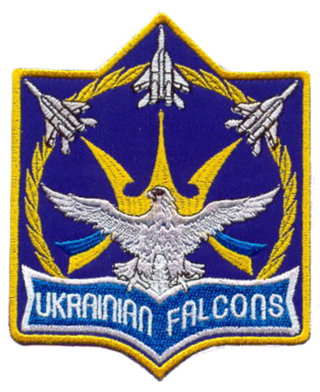
The Ethiopian National Defense Force (ENDF) is the military force of Ethiopia. Civilian control of the military is carried out through the Ministry of Defense, which oversees the Ground Forces, Air Force, Naval Force as well as the Defense Industry Sector.

The Sukhoi Su-27 is a Soviet-origin twin-engine supersonic supermaneuverable fighter aircraft designed by Sukhoi. It was intended as a direct competitor for the large US fourth-generation jet fighters such as the Grumman F-14 Tomcat and McDonnell Douglas F-15 Eagle, with 3,530-kilometre (1,910 nmi) range, heavy aircraft ordnance, sophisticated avionics and high maneuverability. The Su-27 was designed for air superiority missions, and subsequent variants are able to perform almost all aerial warfare operations. It was designed with the Mikoyan MiG-29 as its complement.

The Mikoyan MiG-29 is a twin-engine fighter aircraft designed in the Soviet Union. Developed by the Mikoyan design bureau as an air superiority fighter during the 1970s, the MiG-29, along with the larger Sukhoi Su-27, was developed to counter new U.S. fighters such as the McDonnell Douglas F-15 Eagle and the General Dynamics F-16 Fighting Falcon. The MiG-29 entered service with the Soviet Air Forces in 1983.

The Mikoyan-Gurevich MiG-23 is a variable-geometry fighter aircraft, designed by the Mikoyan-Gurevich design bureau in the Soviet Union. It is a third-generation jet fighter, alongside similar Soviet aircraft such as the Su-17 "Fitter". It was the first Soviet fighter to field a look-down/shoot-down radar, the RP-23 Sapfir, and one of the first to be armed with beyond-visual-range missiles. Production started in 1969 and reached large numbers with over 5,000 aircraft built, making it the most produced variable-sweep wing aircraft in history. The MiG-23 remains in limited service with some export customers.

The Syrian Air Force, officially the Syrian Arab Air Force, is the air force branch of the Syrian Armed Forces. It was established in 1948. Land-based air defense systems are grouped under the Syrian Arab Air Defense Force, which split from both the Air Force and the Army.

The VympelR-73 is a short-range air-to-air missile developed by Vympel NPO that entered service in 1984.

The Vympel R-27 is a family of air-to-air missile developed by the Soviet Union. It remains in service with the Russian Aerospace Forces, air forces of the Commonwealth of Independent States and air forces of many other countries as standard medium range air-to-air missile even though they have the more advanced R-77.

The Ukrainian Falcons were the aerobatic demonstration team of the Ukrainian Air Force. It was established in 1995 as a team of 6 MiG-29 aircraft and disbanded in 2002.

The Eritrean–Ethiopian War, also known as the Badme War, was a major armed conflict between Ethiopia and Eritrea that took place from May 1998 to June 2000.
The Kh-29 is a Soviet air-to-surface missile with a range of 10–30 km. It has a large warhead of 320 kg, has a choice of laser, infrared, active radar or TV guidance, and is typically carried by tactical aircraft such as the Su-24, Su-30, MiG-29K as well as the Su-25, giving these aircraft an expanded standoff capability.

The Yemeni Air Force is the air operations branch of the Yemeni Armed Forces. Numbers of aircraft can not be confirmed but serviceability of these aircraft is low. Aircraft have been acquired by donations from other countries supporting either the Soviet Union or the United States during the Cold War. However, most of the air force was destroyed by airstrikes during the Saudi Arabian-led intervention in Yemen.

The Moldovan Air Force, known officially as Air Forces Command is the national air force of Moldova. It was formed following Moldova's independence from the Soviet Union in August 1991 and is part of the National Army of the Armed Forces of the Republic of Moldova.

The Ethiopian Air Force (ETAF) is the air service branch of the Ethiopian National Defence Force. The ETAF is tasked with protecting the national air space, providing support to ground forces, as well as assisting civil operations during war.

The Armenian Air Force is the air arm of the Armed Forces of Armenia formed by independent Armenia in 1992 in the wake of the dissolution of the Soviet Union. Outside its conventional name, it has also been referred to as the Aviation Department of the Armenian Armed Forces. It is organized and equipped principally to provide Armenian ground forces with tactical air support in the form of ground attack and airlift in mountainous terrain. It provided effective support during the battles with Azerbaijan in the Nagorno-Karabakh region from 1992 to 1994.
The Eritrean Air Force (ERAF) is the air service branch of the Eritrean Defence Forces.
The Uganda–Tanzania War of 1978–79 included an air campaign, as the air forces of Uganda and Tanzania battled for air superiority and launched bombing raids. In general, the conflict was focused on air-to-ground attacks and ground-based anti-aircraft fire; only one dogfight is known to have occurred.

Uganda People's Defence Force Air Force, more commonly known as Ugandan Air Force, is the branch of the Uganda People's Defence Force that deals with the air warfare. Its headquarters is located at Entebbe, Uganda. The current air force commander is Charles Lutaaya, while Emmanuel Kwihangana serves as chief of air staff.
The 103rd Commando Division were the special forces of the Ethiopian Ground Forces under the People's Democratic Republic of Ethiopia. It was activated and began training in January 1987. It was part of the 604th Corps and was described as "the cream of the Ethiopian Army".













